Maps of the Antique
Mediterranean Sea
 The Romans The Romans
 Overview Overview
 Some dates Some dates
 Archaeological sites Archaeological sites
 Roman art Roman art
 Coinage Coinage
 Language and Writing Language and Writing
 Roman Gaul Roman Gaul
 Archaeological sites Archaeological sites

|
ROMAN COINS
A field like the Roman coinage is immense, for its duration (one millenium) as well as for its geographical extent (all the Mediterranean area) and for the variety of its production. Many collectors however make the best of it, while limiting themselves to a particular aspect such as the portraits of emperors – which are often of great quality - the production of one city, the mythological characters on coins, etc.
It is worth mentioning that many coins are affordable for little money, and - for treasure hunters - that it is not at all unusual to find some in the French countryside, with the satisfaction of saying “I found it by myself” (but keep in mind that the use of the metal detectors is generally prohibited !). Lastly, since this coinage has been thoroughly studied, you may rely on precise guides to improve your knowledge on this field.
Overview
The Roman coinage extends over a whole millenium (from the 4th century B.C to the 5th century A.D.) and on all the Mediterranean area. It however appeared late, in comparison with other countries of this area.
The coinage of the Roman Republic began with some silver currencies allowing to trade with the Greek colonies of southern Italy, and also especially with large cast bronze coins in central Italy where this resource was more common.
At the beginning of the Roman Empire, under Augustus, appeared also gold coinage. The political and economic crises of the 3rd century resulted in an inflation which lead to a collapse of the currencies’ value. In the 4th century, Diocletian tried in vain to revalue the silver and bronze currencies, but Constantin Ist managed to create a stable system based on the solidus of 4,5 grams gold, which will kept its stability from the Eastern Roman empire to the Byzantine empire, where it was called nomisma. It remained unaffected by devaluation until the 11th century, under the Comneni, an extraordinary seven centuries stability.
.
The coinage of the Roman Republic
Origin
Until 400 B.C., the Romans practised barter often based on the “heads of cattle”, though knowing the Greek currencies. They then started to build up a system based on bronze ingots, the Aes rude (rough ore), which had neither a fixed weight nor a precise shape, and none of the marks which define a currency. The first markings represented cattle - what remembers the initial barter - or weapons. At the beginning of the 3rd century, the bronze masses took a more regular shape; if their weight remains unfixed, it is at least engraved on them (Aes signatum).
The Aes grave
At last, in 289 B.C., the Aes grave (heavy ore) appeared, a real currency having the shape of a bronze disc, weighing a pound (324 grams), which was divided into 2 semis, or 3 triens, or 4 quadrans, or 6 sextans, or 12 uncias (ounces). One may notice here the interest of this “base 12” counting to define fractions, compared to decimals! The coins were cast, and showed a relief depending on their value: Janus for the As, Minerva for the Semis, etc. About 280-270, the coins began to be struck.
When the Punic Wars began, they required considerable spending for building the fleet: in order to cope with this, Rome devaluated its currency, that is to say reduced the bronze weight of each coin. Towards 250, the as weighed only ca. 280 grams.
Multiples of them appeared, like the sesterce and the dupondius. Silver, which was used only in imitation of the Greek colonies of southern Italy during their conquest, entered in 214 B.C. in the Roman coinage, partly thanks to the silver that had been taken during the plundering of Syracuse in 212. The Denarius, which weighs 4,5 grams silver, was worth 10 as… which had been reduced in the meanwhile to 53 grams bronze! On Denarii, the allegorical characters inspired by mythology dominate (for example, a victory on a chariot dragged by two horses).
Devaluations went on, sometimes affecting silver, sometimes bronze currency. The sesterce (1/4 denarius) became the current unit of the 2nd century. Ca. 140 B.C., it is worth 4 as. Inscriptions appear on the background of the coin, as well as the names of the monetary magistrates. The allegorical images from mythology are reused for their glory.
In the 1st century B.C., it was disputed for a long time whether the actors of civil wars should engrave their portrait on coins. About 80 B.C., the production of bronze coins almost stopped, but the as reappeared sometimes during the later periods.
The coinage of the early Roman empire
Augustus, who became emperor in 23 A.D., reorganized the monetary system and introduced a gold currency, the aureus of 7,85 grams, which was worth 25 denarii (or 100 sesterces, or 200 dupondii). The sesterce - from then on made of brass - remained the usual currency, and all the successive emperors were watchful to have their portraits on them, and even those of the members of their family. The inscriptions on the coins (legend) deliver the whole imperial titulature. The reverse of the coins is a space for propaganda, using largely allegories.
The silver Cistophore was used in Asia Minor, where its worth was 3 Roman denarii or 4 Greek drachms.
In the course of years, the Denarius was devaluated in turn:
- under Severe Septime, ca. 200 A.D., its silver content passed from 70% to 50% silver, and the weight of the aureus from 8,1 to 6,5 grams gold,
- in 215, Caracalla introduced a double-denarius called antoninian which weighed only 1,5 denarius (5,07g), and contained 50% silver,
- in 258, under the reign of Valerian, the antoninian silver content was approximately 20%,
- under the reign of Claude the Gothic (268-270), its content fell to only 3 or 4% and its aspect was closer to that of a bronze coin.
The sesterce was produced up to the reign of Gallienus (260-268). In 274, Aurelian reformed the currency system and increased the weight of the antoninian, which was then called aurelianus. He also attempted to reintroduce the bronze as and the sesterce.
The coinage of the late Roman empire
Diocletian, in 294, attempted a new monetary reform.
The aureus passed from 1/50 to 1/60 of gold pound. He created also the argenteus (3,4g silver), the follis or nummus made of silver plated bronze, which is worth 5 denarii, and the billon which is worth 2 denarii.
Since inflation persists, Constantine (306-337) created finally a new system, where the solidus (4,5g gold) replaced the aureus. It was supposed to ensure – as the name shows - a certain stability – and it reached it. Its submultiples were the semissis (1/2), the tremissis (1/3), the miliares, the silicus, the half silicus.
In the 5th century, the monetary system changed. Its most important components were the solidus and the tremissis. The production of silver coins stopped practically. As for bronze coins, they survived after 415 in the Western and 425 in the Eastern Roman empire as a small coin weighing around one gram.
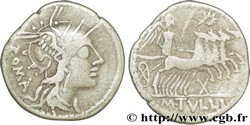
Rome, 120 B.C., Denarius, silver, diameter 21mm, 3,61g. |
TULLIA
In 120 B.C., the two consuls were P. Manilius and Caius Papirius Carbo.
Document CGB, www.cgb.fr |
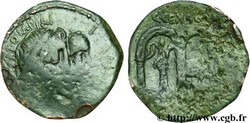
Rome, 88 B.C., as, copper, diameter 27mm, 13,32g. . |
MARCIA - Caius Marcius Censorinus
Caius Marcius Censorinus should be identified as one of the partisans of Marius, the one who accused Sylla of embezzlement when he came back from the East. One of the chiefs of Marius’ party, it entered Rome with Marius and Cinna in 87 B.C. and was one of the main instigators of the massacres which followed. True to the memory of Marius, he fought Sylla, but was taken prisoner at the battle of the Collin Gate in 82 B.C. and was executed.
Document CGB, www.cgb.fr |
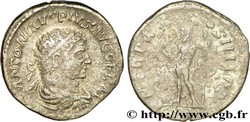
Rome, 217, antoninian, silver, diameter 21,5mm, 4,85g. |
CARACALLA Marcus Aurelius Antoninus Augustus
The antoninian was created in 215. This coin, characterized by the presence of a radiant (solar) crown, weighs an average of 5,07g and is defined as 1/64 of pound (1 pound = 325g) with a silver content of 50%. The denarius, on its side, weighs an average of 3,38g, that is to say 1/96 of pound, also with a silver content of 50%. Thus the antoninian weighs 1,5 denarius and is given for 2 denarii.
Document CGB, www.cgb.fr |
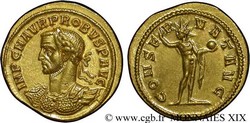
Ticinum, Pavia, v. 278, Aureus, gold, diameter 21,5mm, 6,49g. |
PROBUS
Probus was born on August 19, 232 in Sirmium. he performed a brilliant military career under the reigns ranging from Valerian 1st to Tacitus. He is commander of the East army whenTacitus dies, is immediately proclaimed emperor and overcomes easily Florian who is murdered. The time are difficult. The Rhenodanubian Limes fails under the pressure of Germanic invasions. Probus restores peace in Gaul, in Germania, then in Rhaetia where he inflicts a severe defeat to the German tribes, in Thrace where he defeats the Sarmates and the Scythians, in Asia Minor which he clears out from plunderers and pamphylian pirates, and finally in Africa where he puts an end to the incursions of Blemmyes. In 280, he signs the peace with Vahram II, the sassanian monarch. He must face the usurpations of Saturninus, Bonosus and Proculus. Probus, having triumphed over all its opponents, returns to Rome into 281 and celebrates his victories. Before preparing a new expedition against Sassanians, he was killed by his own soldiers in Sirmium in 282.
Document CGB, www.cgb.fr |
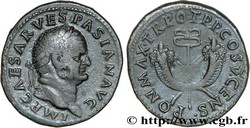
Samosate or Antioch, 74, Dupondius, copper, diameter 28mm, 12,16g. |
VESPASIAN Titus Flavius Sabinus Vespasianus
Vespasian was born on November 17, 9 in Flacrines, near Reate (in Sabine country). He belongs to the Italian municipal middle-class. Aedile in 38, praetor in 40, consul in 51, proconsul of Africa in 63, he commands with Claude the expedition of Brittany.
Neron entrusts him with three legions and a proconsulairy imperium to crush the revolt of Judaea in 66. He is appointed as Augustus on July 1, 69 in Alexandria and his sons, Titus and Domitian, are elevated as Caesars. Vitellius is eliminated on December 20, 69. Titus is directly included in the government by his father as of 71. His reign is devoted to the political and economic restoration of Rome. In 73, he becomes Censor. He dies in Reate on June 24, 79.
Document CGB, www.cgb.fr |
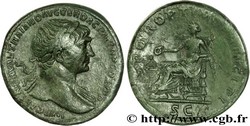
Rome, 107, Sesterce, copper, diameter 33mm, 21,81g. |
TRAJANUS Marcus Ulpius Traianus Augustus
Trajanus was born on September 18, 53 in Italica, near Sevilla in Spain, like his ward Hadrian. He belongs to a family of colonists who settled down in Spain. After a brilliant military career under the Flavians, he is consul in 91 and legate of High Germania when he is adopted by Nerva in 97 to succeed to him. After Nerva’s death, he becomes Augustus. His reign will be devoted to many military campaigns against the Germans on the Rhenan Limes, which gets him the title of Germanicus, then the two dacic wars against Decebalo end with the annexation of Dacia. Trajanus prepares a campaign against the Parthians, the turbulent and powerful neighbors on the East. He leaves Rome for the East, establishes his headquarter in Antioch before invading the Parthian kingdom. He will go up to Ctesiphon (Seleucia on the Tigris). When he dies, on August 8, 117, The Empire is at its apogee with its largest territorial extension.
Document CGB, www.cgb.fr |
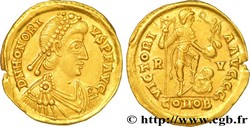
Ravenna, 408-423, Solidus, gold, diameter 20,5mm, 4,44g. |
HONORIUS Flavius Honorius
Honorius, born in 384, was appointed as Augustus in 393. With his father died, he inherited the West, Stilicono being the regent. The beginning of the 5th century is maked with a wave of invasions without equivalent before. The Limes failed definitively under the pressure. In 410, even Rome was stormed. The western empire is in full decay. Many usurpations occur in Brittany with Constantine III, in Gaul with Constans, Jovinus and Sebastian, in Spain with Maximus and in Italy with Attalos. Honorius dies in Ravenna in 423 after a thirty years reign, leaving a disintegrated empire.
Document CGB, www.cgb.fr |
|

















